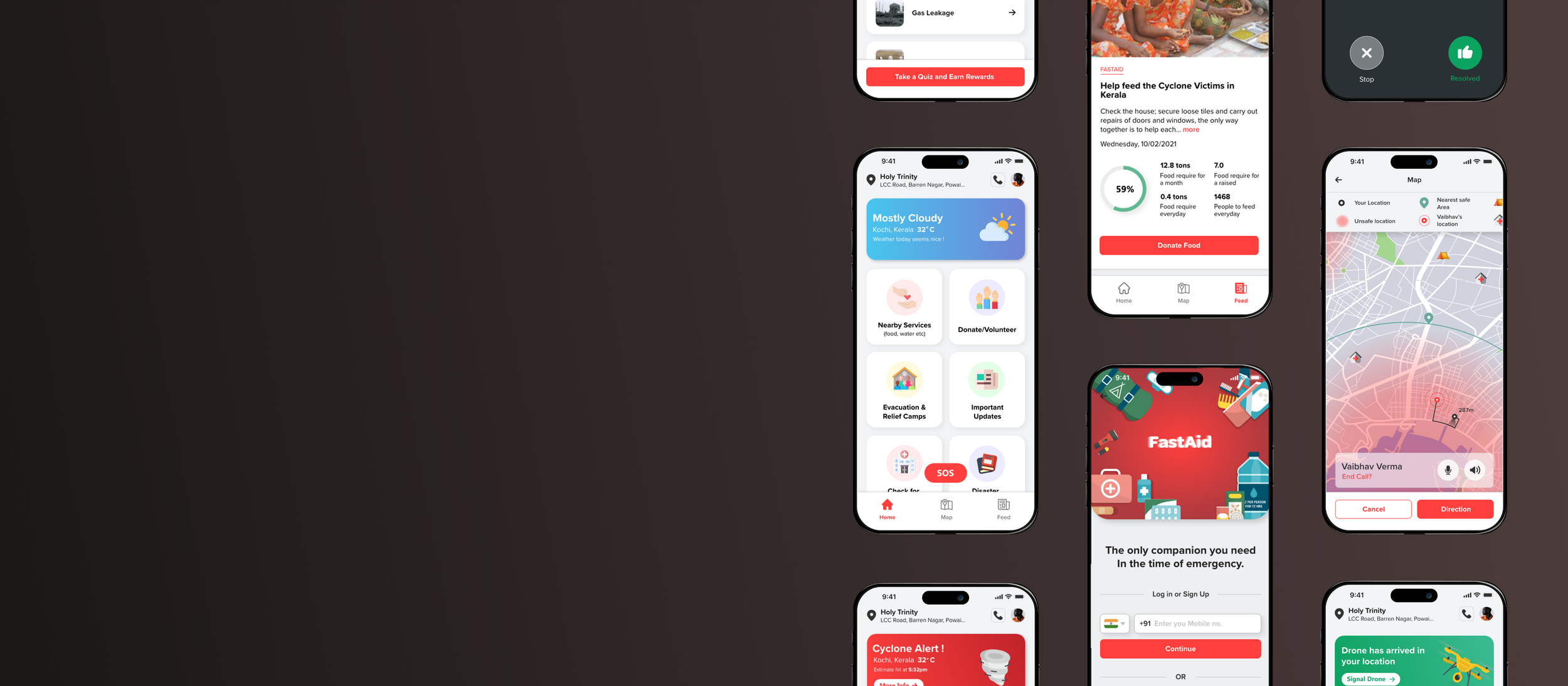
FASTaid:
1 Week design challenge.
FastAid is an app/solution which allows the community (victims and volunteers) to connect with one another during the time of disaster with the help of different NGOs and DRFs collaborating to rescue relief and rehabilitate.
Design Brief
Connect people in a disaster situation with people who can provide help.
Develop for both stakeholders – help seeker, and help provider. Consider on-boarding if it is more unique than most onboardings, how will the service originate, or initiate, what will be the service, how will it work?
This is not an exercise in technology, though it will be helpful to understand how you think your solution can be implemented. Share your process, or however you wish to communicate your thought process. We want to see the final output, AND understand how you think about the problem and interpret it into a solution.
Design Process
Due to the limited timeframe, I implemented a very accelerated design process for the project.
Understanding the system
To gain a deeper understanding of the current disaster management system and its key players, I conducted an initial analysis before embarking on my primary and secondary research. This allowed me to ask more insightful questions and conduct a more thorough analysis of the existing system and applications.
I also read and watched the following -
Disaster Management in India
https://www.unisdr.org/2005/mdgs-drr/national-reports/India-report.pdf
The Phoenix State - Documentary on Kerala Floods | CPC | Gilbert https://www.youtube.com/watch?v=h09B08eDGa8&t=2s
Living Through Australia’s Black Summer: Fire Country https://www.youtube.com/watch?v=lkTN08LmNK4
Kerala: Disaster Management Plan 19-20 https://sdma.kerala.gov.in/wp-content/uploads/2020/12/Annual-report_KSDMA-Sphere-partnership-project-2019-2020-1-1-1.pdf
Role of Non Governmental organization and in Disaster Management https://www.researchgate.net/publication/301360154_Role_of_Non_Governmental_organization_in_Disaster_Management
To summarise my understanding of the system refer to the diagram below -
Secondary research
In order to understand the landscape of disaster management applications, I conducted a comprehensive analysis of five different applications and two case studies. Through this analysis, I sought to identify the services provided by each application, as well as their respective strengths, weaknesses, and unique features. Additionally, I examined the efficiency of each application in delivering its services and identified potential elements that could be incorporated into our own application.
The applications and case studies analyzed included NDMA India, AarogyaSetu App, Donate Kart, UAE National Security, Kenya Red Cross, and Red Cross.
Primary Research
Total of 3 interviews were conducted,
I conducted phone interviews with individuals who have experienced disasters firsthand. During these interviews, I asked about their experiences during each of the four phases of a disaster in a respectful and conversational manner, aiming to create an open dialogue rather than a formal interview. The interviewee demographic is as follows -
Interviewee 1: An elderly man who has witnessed Bhopal Gas Tragedy firsthand.
Interviewee 2: A girl in her 30s was one of the victims of the Kerala floods in 2018.
Interviewee 3: A male student who volunteer to help during the Kerala floods while his family was the victim.
Mapping the insights and problems faced
Based on my interviews, I put all my insights and problems in the form of a Map.
Stakeholder mapping
In order to gain a comprehensive understanding of the pivotal contributions made by each individual and how their roles interrelate, it is essential to delve into the dynamics at play.
Creating personas
Meet Shuvam,
Shuvam is a banker hailing from Ranchi who recently relocated with his family to Kottayam. Dedicated to providing excellent service to his clients, he goes above and beyond to assist others in any way possible, all while maintaining a strong focus on his family.
In particular, Shuvam prioritizes the safety and happiness of his parents and elder sister, who is soon to welcome a new addition to the family. While heavy rains and floods have impacted Kerala, Shuvam has yet to experience their full force.
However, he recognizes that floods are growing increasingly severe each year and worries about the potential consequences if proactive measures aren't taken to prepare for them.
Meet Aarcha,
Aarcha is a compassionate medical student hailing from Kochi and currently pursuing her studies in Mumbai. Driven by a strong desire for social justice, she seeks to create a world where everyone can experience happiness and security, which is why she has chosen medicine as her career.
In addition to her studies, Aarcha is an active climate activist on social media, using her platform to make a positive impact in any way she can. Recently, she came across news of the devastating floods in Kerala, which have left many without basic necessities, including essential medicines.
As a Keralite herself, Aarcha feels a deep sense of responsibility to help her community and is eager to make a difference. However, she is currently unsure of how to best lend her support.
Ideation and making the information Architecture
With the stakeholders' needs and project scope top of mind, I engaged in a process of ideation to tackle the issues at hand. Via brainstorming, I posed HMW (How Might We) questions and generated a multitude of potential solutions.
From this creative exploration, I selected the most promising concepts and translated them into an actionable plan by developing an information architecture. This was then translated into wireframes to give shape to the proposed solutions.
design systems
FINAL PROTotypes
Onboarding
App Features
Scenario 1 (Preparedness)
Scenario 2 (Rescue)
Scenario 3 (Rehabitation)
Scenario 4 (Relief)
UI Screens
Thank You for being generous with your time




















